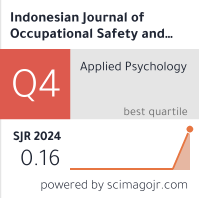Assessment of Occupational Heat Stress in A Selected Indonesian Steel Mill
Downloads
Introduction: Workers in the Indonesian steel manufacturing industry are subject to many heat stress risk factors, ranging from the equatorial climate to physically demanding work tasks which may result in heat- related illnesses and reduced worker productivity. Hence, a study was conducted at Steel Mill X to assess the level of heat stress among its workers, determine the association of related factors and to provide meaningful recommendations. Methods: This study uses a descriptive cross-sectional method to assess workers' heat risk level and its association with individual, occupational and heat stress symptoms. An online questionnaire was used to collect primary data yet WBGT monitoring data were provided by Steel Mill X as secondary data. Results: The heat stress risk level score ranged from 48 to 140 (M=89.8, SD=±31.0). 122 workers were in the very high-risk category (75.8%). Occupational factors which had a statistically significant association with heat stress risk category includes: work area, length of exposure, air movement, hot surfaces, confined space, clothing factors and WBGT; while heat stress-related symptoms which were associated include headache, fatigue, profuse sweating, extreme thirst and increased body temperature. The absence of significant association between individual factors and heat stress risk category eliminates it as a confounding factor, suggesting occupational factors was the main variable. Conclusion: Control measures such as improving the supply of drinking water and maintenance of cooling systems should be implemented as soon as possible to prevent heat stress among workers.
Arifwidodo, S.D. and Chandrasiri, O. (2020) ‘Urban heat stress and human health in Bangkok, Thailand', Environmental Research, 185(March), p. 109398.
Bezruchka, S. A. (2008). Chapter 9 - Motion, Cold and Heat Disorders. In E. C. Jong & C. Sanford (Eds.), The Travel and Tropical Medicine Manual (Fourth Edition) (pp. 132-151). W.B. Saunders. CDC (2022b) Assessing Your Weight.
CDC (2020b) Employer Information for Heat Stress Prevention during the COVID-19 Pandemic.
CDC (2020a) Heat Stress.
Chan, A. P. C., Yang, Y., Song, W.-f., & Wong, D. P. (2017). Hybrid cooling vest for cooling between exercise bouts in the heat: Effects and practical considerations. Journal of Thermal Biology, 63, 1-9.
Choupani, A. et al. (2018) ‘Biological monitoring of occupational exposure to dust among aluminium foundry workers', Russian Open Medical Journal, 7(2), pp. 1–6.
Falahati, M., Alimohammadi, I., Farshad, A. A., Zokaei, M., & Sardar, A. (2012). Evaluating the reliability of WBGT and P4SR by comparison to core body temperature [Article]. Iran Occupational Health, 9(3), 22-31.
Gutierrez, G. (2021, June 17, 2021). Headaches and the heat - what really is causing the pain? Baylor College of Medicine. Retrieved 14 July from https://www.bcm.edu/news/headaches-heat-causing-pain
Hall, K.S. et al. (2017) ‘Physical performance across the adult life Span: Correlates with age and physical activity', Journals of Gerontology - Series A Biological Sciences and Medical Sciences, 72(4), pp. 572–578.
Hussin, M., Ismail, M. R., & Ahmad, M. S. (2013). Subjective Perception of Thermal Comfort Study in Air-conditioned University Laboratories. Procedia - Social and Behavioral Sciences, 91, 192-200.
Kavouras, Stavros A., (2013). Thirst: Survival Instinct or Sensitive Fluid Balance Homeostatic Mechanism?. Nutrition Today 48(4):p S7-S9.
Krishnamurthy, M. et al. (2017) ‘Occupational Heat Stress Impacts on Health and Productivity in a Steel Industry in Southern India', Safety and Health at Work, 8(1), pp. 99–104.
Mohammadi, H. et al. (2021) ‘Assessment of sexual hormones in foundry workers exposed to heat stress and electromagnetic fields', Reproductive Toxicology, 101(December 2020), pp. 115–123.
Morimoto, T., Itoh, T., & Takamata, A. (1998). Chapter 24 Thermoregulation and body fluid in hot environment. In H. S. Sharma & J. Westman (Eds.), Progress in Brain Research (Vol. 115, pp. 499-508).
OECD (2021) Working Age Population.
Phanprasit, W. et al. (2021) ‘Climate Warming and Occupational Heat and Hot Environment Standards in Thailand', Safety and Health at Work, 12(1), pp. 119–126.
Speakman, J.R. (2018) Obesity and thermoregulation. 1st edn, Handbook of Clinical Neurology. 1st edn. Elsevier B.V.
Takebayashi, H. (2018) ‘A simple method to evaluate adaptation measures for urban heat island', Environments - MDPI, 5(6), pp. 1–13.
Xiang, J. et al. 2014 'Health Impacts of Heat Workplace Exposure:An Epidemiological Review', Journal of Industrial Health, Volume 52 Issue 2 pages 91-101.
Wang, J. et al. (2023) ‘Contrasting effects of lake breeze and urbanization on heat stress in Chicago metropolitan area', Urban Climate, 48(October 2022), p. 101429.
Wang, J. et al (2019) The association between heat stroke and subsequent cardiovascular diseases, PLoS ONE 14(2): e0211386.
World Steel Association (2019) ‘World Steel Association in Figures 2019', World Steel Association, pp. 1–30.
World Steel Association (2020) ‘Major steel-producing countries 2018 and 2019 million', 2020 World steel in figures, (30 April), pp. 1–8.

This work is licensed under a Creative Commons Attribution-NonCommercial-ShareAlike 4.0 International License.

In order to be accepted and published by The Indonesian Journal of Occupational Safety and Health, Author(s) who submit an article should complete all the review process. The copyright of received articles assigned to the The Indonesian Journal of Occupational Safety and Health and Department of Safety and Health, Universitas Airlangga as publishers of the journal. The intended copyright includes the rights to publish articles in various forms (including reprints).
The Editorial Team of The Indonesian Journal Of Occupational Safety and Health and Department of Safety and Health strive to ensure that no errors occur in the articles that have been published, both data errors and statements in the article.
Users of this website will be licensed to use materials from this website following the Creative Commons Attribution-NonCommercial-ShareAlike 4.0 International License. No fees charged. Please use the materials accordingly.
------------------------------------------------------------------------------------------------------------------------------------------------------------------------------------------
Attribution ” You must give appropriate credit, provide a link to the license, and indicate if changes were made. You may do so in any reasonable manner, but not in any way that suggests the licensor endorses you or your use.
NonCommercial ” You may not use the material for commercial purposes.
ShareAlike ” If you remix, transform, or build upon the material, you must distribute your contributions under the same license as the original.







 How to Submit Articles in OJS
How to Submit Articles in OJS

























